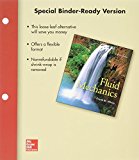
Concept explainers
Overall pressure drop
Answer to Problem 6.118P
Explanation of Solution
Given information:
All pipes are concrete, and roughness is equal to
The fluid is water at

In parallel pipe system the pressure drop is same in each pipe.
Total flow is sum of individual flows,
The velocity
The Reynolds’s number is defined as,
Roughness ratio is equal to,
The friction factor can be determined by,
The total head loss
Calculation:
For pipe a,
Find the velocity of the flow in pie a,
Determine the Reynolds’s number,
Assume the kinematic viscosity of water at
The roughness ratio is equal to,
To determine the friction factor,
To determine the head loss in pipe a,
For pipes
To find velocity of the flow in each pipes,
By equating the head losses in each pipe,
If,
Therefore,
By substituting,
To find relevant Reynolds’s number,
The relevant roughness ratio will be,
The relevant friction factor will be,
By substituting these values in equation (1),
Therefore,
To find the head loss across pipe c,
Therefore the total head loss will be,
To find pressure drop between point 1 and point 2
Consider the specific weight of the water as
Conclusion:
The pressure drop
Want to see more full solutions like this?
Chapter 6 Solutions
Package: Loose Leaf For Fluid Mechanics With 1 Semester Connect Access Card
 Elements Of ElectromagneticsMechanical EngineeringISBN:9780190698614Author:Sadiku, Matthew N. O.Publisher:Oxford University Press
Elements Of ElectromagneticsMechanical EngineeringISBN:9780190698614Author:Sadiku, Matthew N. O.Publisher:Oxford University Press Mechanics of Materials (10th Edition)Mechanical EngineeringISBN:9780134319650Author:Russell C. HibbelerPublisher:PEARSON
Mechanics of Materials (10th Edition)Mechanical EngineeringISBN:9780134319650Author:Russell C. HibbelerPublisher:PEARSON Thermodynamics: An Engineering ApproachMechanical EngineeringISBN:9781259822674Author:Yunus A. Cengel Dr., Michael A. BolesPublisher:McGraw-Hill Education
Thermodynamics: An Engineering ApproachMechanical EngineeringISBN:9781259822674Author:Yunus A. Cengel Dr., Michael A. BolesPublisher:McGraw-Hill Education Control Systems EngineeringMechanical EngineeringISBN:9781118170519Author:Norman S. NisePublisher:WILEY
Control Systems EngineeringMechanical EngineeringISBN:9781118170519Author:Norman S. NisePublisher:WILEY Mechanics of Materials (MindTap Course List)Mechanical EngineeringISBN:9781337093347Author:Barry J. Goodno, James M. GerePublisher:Cengage Learning
Mechanics of Materials (MindTap Course List)Mechanical EngineeringISBN:9781337093347Author:Barry J. Goodno, James M. GerePublisher:Cengage Learning Engineering Mechanics: StaticsMechanical EngineeringISBN:9781118807330Author:James L. Meriam, L. G. Kraige, J. N. BoltonPublisher:WILEY
Engineering Mechanics: StaticsMechanical EngineeringISBN:9781118807330Author:James L. Meriam, L. G. Kraige, J. N. BoltonPublisher:WILEY





